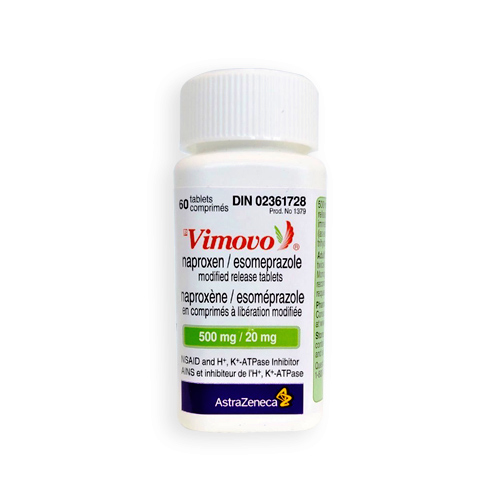What is Vimovo used for?
Vimovo is used in the treatment of the symptoms and signs of juvenile idiopathic arthritis, rheumatoid arthritis, osteoarthritis, and ankylosing spondylitis when there’s a big risk of stomach bleeding or ulcers. Vimovo contains naproxen and esomeprazole. Vimovo shouldn’t be used for sudden pain relief. This naproxen works slower than other naproxen products because of the delayed-release coating. If you’re using Vimovo in the treatment of a chronic condition like arthiritis, discuss non-drug treatment options with your doctor as well as other medications for pain relief. Naproxen is called a nonsteroidal anti-inflammatory drug (NSAID). It reduces swelling, pain, and joint stiffness. It can cause stomach ulcers, especially if you already have a history of stomach ulcers. Esomeprazole is called a proton pump inhibitor (PPI) that blocks the production of acid in the stomach. The combination in Vimovo provides the benefits of naproxen while reducing the risk of ulcers and bleeding that stem from Naproxen use.

Vimovo Information
How to Use Vimovo?
Read the informational information provided when you start Vimovo and whenever you get a refill. Take Vimovo orally, as directed by your doctor generally twice per day around 30 minutes before eating. Take Vimovo with an 8 oz glass of water unless your doctor has told you otherwise.
Don’t like down for about 10 minutes after taking Vimovo. Do not crush, break, chew or dissolve the tablet as this can destroy the slow release of Vimovo which can lead to an increase in side effects. You can also take antacids while on this medication if needed. Your dosage will be based on your condition and response to treatment, and in children it’ll be based on weight as well. In order to reduce the risk of serious side effects take Vimovo at the lowest effective dose for the shortest possible time.
Don’t change anything about the way you take Vimovo without first discussing it with your doctor as taking it more frequently, taking a larger dose, or taking it for longer than prescribed can increase your risk of side effects. You must use Vimovo consistently to get the best results from it so use it at the same times daily to help aid your memory. If your condition gets worse or doesn’t improve talk to your doctor. The risk of side effects will increase over time so ensure you discuss your treatment plan with your doctor.
Vimovo Drug Interactions?
Drug interactions can affect how your medications work or leave you at a higher risk for unwanted side effects. Sometimes two drugs that interact should never be used together. However, sometimes your doctor can make adjustments to your medications that allow you to take both safely.
The following medications interact with Vimovo:
This is not a complete list of drug interactions with Vimovo. Ensure you give your doctor a complete list of medications that you are taking. This list should include all prescription and non-prescription drugs as well as herbal products and vitamins. If you have questions about drug interactions with Vimovo you can call us at 1-844-416-4282 and ask to be transferred to a licensed pharmacist for counselling.
Vimovo Drug Warning?
Drugs that are categorized as nonsteroidal anti-inflammatory drugs (such as naproxen) can occasionally increase the risk of stroke or heart attack. This effect is most likely when you’ve taken the drug for a long time but can happen at any time. If you have increased risk for heart disease or do have heart disease this side effect becomes more likely.
Don’t take Vimovo immediately before or following heart bypass surgery. Vimovo can rarely cause serious stomach or intestinal bleeding (this is rarely fatal) which can occur without warning symptoms and at any time throughout the course of your treatment. This side effect is more common in older adults. Esomeprazole decreases the risk of bleeding.
If you notice any of the serious side effects seek medical attention immediately: severe dizziness, chest/left arm/jaw pain, vision changes, black stools, slurred speech, weakness on one side of the body, vomit that looks like coffee grounds, persistent abdominal pain.
